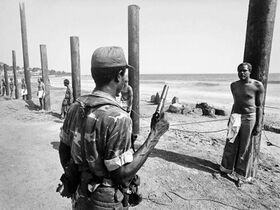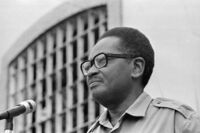1980 Maracan coup d'état attempt
This article is incomplete because it is pending further input from participants, or it is a work-in-progress by one author. Please comment on this article's talk page to share your input, comments and questions. Note: To contribute to this article, you may need to seek help from the author(s) of this page. |
| 1980 Maracan coup d'état attempt | |||||||
|---|---|---|---|---|---|---|---|
 Soldiers of the Revolutionary Army question Movimento Azul members whilst tied to posts, Guajaratuba, 1980 | |||||||
| |||||||
| Belligerents | |||||||
|
|
| ||||||
| Commanders and leaders | |||||||
|
|
| ||||||
| Strength | |||||||
| est. 2,000[a] | 7,000 | ||||||
| Casualties and losses | |||||||
|
129 killed 1,026 POWs | 391 killed or injured | ||||||
The 1980 Maracan coup d'état attempt, referred to in Maracao as the Month of Solidarity (Lusitan: Mês de Solidariedade) or simply O Mês ("The Month") was an attempted coup d'état by the right-wing Movimento Azul, backed principally by Halland and Nuxica, to overthrow Leonardo Alcântara and the Frente Revolucionária de Libertação in an attempt to install a right-wing dictatorship in Maracao aligned against the Association for International Socialism. The coup attempt took place between mid-June and mid-July in 1980, and ended with the capture and execution of its leader, Manuel da Silva, as well mass governmental purges by Alcântara, the imprisonment of most Movimento Azul members and the preservation of Maracao's socialist government.
Background
Since the Liberação in the 1930s led by Renato Guimarães and Josué Couto that freed the island from Mariranan occupation during the Great War, Maracao had been a council communist state aligned with Chistovodia and Swetania, with all three countries espousing relatively similar iterations of socialist ideology. While Maracao was almost directly opposed to much of the Asterias in a geopolitical sense, it remained relatively cooperative on matters of shipping lanes and trade that emerged with Maracao's central location in the Arucian Sea, allowing trade to flow freely and securely through the sea without the threat of interruption. While Maracao was an exemplary democracy and one of the best country's for workers' rights and unionisation, it was still relatively poorly developed by the 1950s, especially compared to its neighbours such as Imagua and the Assimas and Sanslumiere. When Enéas Almeida succeeded to the presidency of Maracao in 1958 upon the death of Matheus Moreno, he devised an ideological plan to distance Maracao from the traditional council communist model employed in much of the socialist world at the time, instead declaring that Maracao was in need of its own, unique version of socialism to ensure maximal development across the country.
Throughout the 1960s, Almeida introduced reforms, policies and delivered speeches that gradually encouraged the promotion of the FRL to the position of a vanguard party in the country, with it quickly becoming the dominant socialist party in Maracan politics. Almeida also attempted to increase Maracan influence abroad, and began utilising Maracao's military dominance among the Arucian states, as well as its relatively high degree of mobility amongst the populace, to begin introducing stricter trade policies and sea enforcement that greatly decreased the security of Arucian trade routes. Whilst Chistovodia was skeptical of the new Maracan government, it continued to send it foreign aid, and along with socialist North Vinalia, provided essential funds that kept the Maracan economy afloat as many Asterian nations embargoed it throughout the mid-1960s, including both Halland and Nuxica. Almeida also pushed to support Chistovodia in its war against Nuxica in the 1970s, and oversaw the training of Chistovodian guerrillas in Maracao. When Almeida left office in favour of his successor Alcântara in 1973, Maracao had vastly increased its development with several new highways, ports and railroads as well as a massive increase in essential infrastructure in much of Maracao's largest cities.
As both Halland and Nuxica had large amounts of shipping passing through the Arucian Sea, it was desirable for both nations to move to secure trade in the region. Halland sent increasing amounts of vessels to Mordred Naval Base in Imagua while Nuxica increased its military funding in the late 1970s back to pre-war levels. Halland began using military vessels to escort essential trade near Maracao, to which Maracao filed a diplomatic complaint with the Community of Nations that was promptly dismissed in March 1978. Maracao began patrolling its own waters more aggressively with its own naval forces and tensions heightened in the straits between the two countries. With the threat of Swetanian involvement looming and public opinion strongly against a second war with Chistovodia, Halland and Nuxica devised Operation Escalona in early 1979, which saw weapons discreetly smuggled into Maracao for the newly-established right-wing Movimento Azul – led by da Silva and strongly supporting alignment with both Halland and Nuxica – through southern port towns that were poorly policed. Da Silva himself was a veteran in the Revolutionary Army and had considerable knowledge of the inner workings of the government as well as influence over other soldiers, which he utilised to recruit for the coup.
Course of the coup
June
Initial attempts to abduct or detain Alcântara were unsuccessful, and on June 18 the main plan to abduct the president whilst he was being driven from Porto Leste to Rozem was foiled. Four MA members were shot and killed whilst two more were injured and detained for interrogation. Later the same day, da Silva hijacked local radio stations in Sanceriz and announced his intent to form "a safer Maracao" and to "restore our land's former glory". The MA ambushed the Juan Andrés Gálvez Base in Sanceriz shortly after and successfully destroyed military supplies at the base and killed around 25 stationed troops at the base. Alcântara declared a national emergency on June 19, dissolving the Revolutionary Congress and created a temporary cabinet consisting of himself, Netuno Pinto, Ivo Varela, Duarte Barboza and Desidério Passos, which was standard wartime policy in Maracao but had not yet been employed in its history. Contrary to other instances of civil conflict, da Silva opted against an active resistance where engagements were sought out with the intent of winning. Instead, they utilised shock-and-awe guerrilla tactics against the government, ambushing divisions, looting stores and causing major civil unrest in nearby towns, especially in Mivaqueiro. Historians theorise that da Silva wished to gradually whittle the Maracan government down before striking at its core later on.
Methods of this weree showcased shortly afterwards, with Ivo Varela being assassinated by a single sniper gunshot wound to the body in São João on June 30, one of the first major acts against the government by the MA that succeeded. Alcântara never reappointed a fifth minister, but chose to remain diligent with his closer four-man council. Alcântara himself was rarely permitted to make public appearances out of fears for his safety. Many of the MA defectors were soldiers and were extremely capable in using firearms, especially from long range. The MA also stirred civil disobedience in Mivaqueiro later on June 30, which was quickly dealt with by Maracan forces stationed in the city.
July
With the lack of coordinated or increased response following the death of Varela, the MA struck directly again with the abduction of Desidério Passos on July 2, utilising insiders who were later found to be Passos' security guards and driver. Once news of the means of abduction had reached Porto Leste, Alcântara began planning purges in local governments as well as the FRL itself to prevent any other major governmental incidents from reoccurring. He attempted to fiercely negotiate the return of Passos in the following days but failed when exorbitant demands were not met and Passos was found dead outside of Sanceriz on July 5. In response, Alcântara massively upped the dedicated resources of the military to combatting the effort, with around 7,000 men actively fighting and searching for the MA in Maracao's mountains and cities. Da Silva's influence over local governments also neutered the influence of the central government over more far-fetched areas of Maracao, and whilst the local councils were nominally dissolved, they still were able to provide logistical and physical aid for da Silva's forces.
Alcântara was almost shot through thick glass delivering an address in Porto Leste on July 8, which would be his last public appearance until after the coup. By now, the MA were on the back foot and were being pushed back into the mountains, out of Mivaqueiro and Sanceriz, by the Maracan army. Helicopters provided regular surveillance of mountain areas which made it increasingly difficult for the MA to conduct surprise attacks in such a small area, and by July 13 were essentially resorting to shock tactics and acts of terrorism against civilians in Mivaqueiro, where around 500 civilians are estimated to have died over the course of the month. Most of the MA forces had been captured by July 21 and da Silva himself was discovered in his hideout in an abandoned mineshaft around 50 kilometres east of Mivaqueiro on July 23. He was executed three days later by the FRL.
Aftermath
The prolonged nature of the coup has a lasting and resounding effect on Maracan society, particularly how Alcântara, the FRL and later presidents viewed the party and the central government. Shortly after da Silva was executed, Alcântara began his purges which imprisoned tens of standing FRL ministers and demoted other ministers from positions of authority, instead replacing them with extreme party loyalists and those willing to follow Alcântara more intensively than previous ministers. The purges effectively centralised the FRL into a universal ideological output for the president to take control of, and gave the president a much greater amount of power over how Maracao was run due to the FRL's position as the country's vanguard party. Governmental success during the coup also contributed extremely positively to the overall opinion of the FRL and socialism within the country.
Some historians agree that precedents set by Alcântara following the coup contributed greatly to the current situation regarding the tenure of incumbent president Adão Costa.
Legacy
Within Maracao, governmental victory and civilian resistance during the 1980 coup attempt is a widely celebrated and well-documented portion of Maracan history, and it is regularly cited by the Maracan government as ideological unity brought about by the rule of the FRL in Maracan politics. As well as this, Alcântara is one of Maracao's most revered presidents and is among the most popular who have held office due to his resilience during the fighting. Outsider sources claim that the Maracan government inflate the numbers and severity of the MA and its attacks throughout Maracao during the days of the coup, and use numbers that are regularly disputed by historians and other countries.
Notes
- ↑ Numbers between 5,000 and 7,000 have been claimed by the Maracan government, although these claims are routinely disputed.
